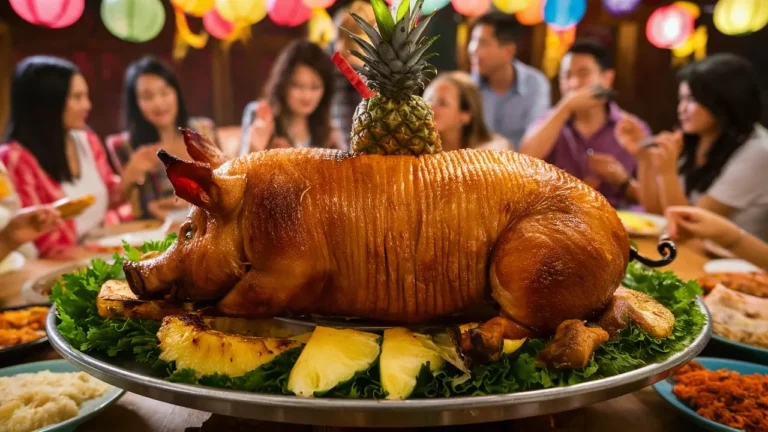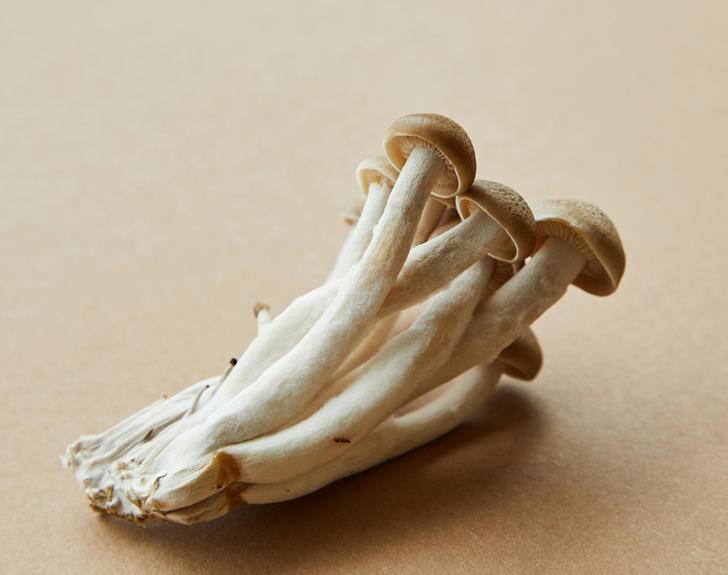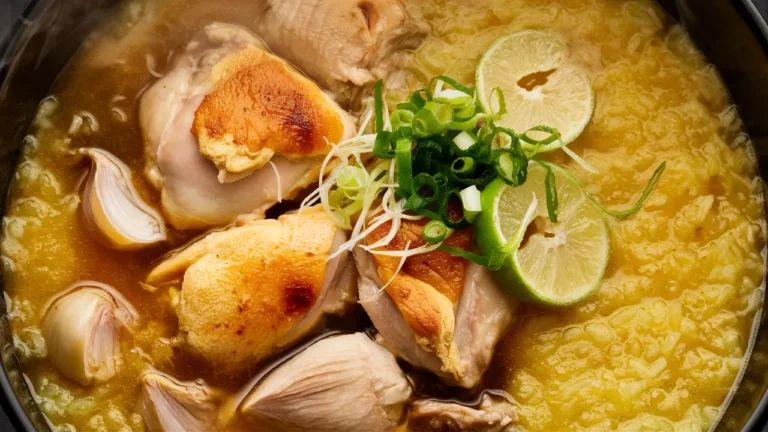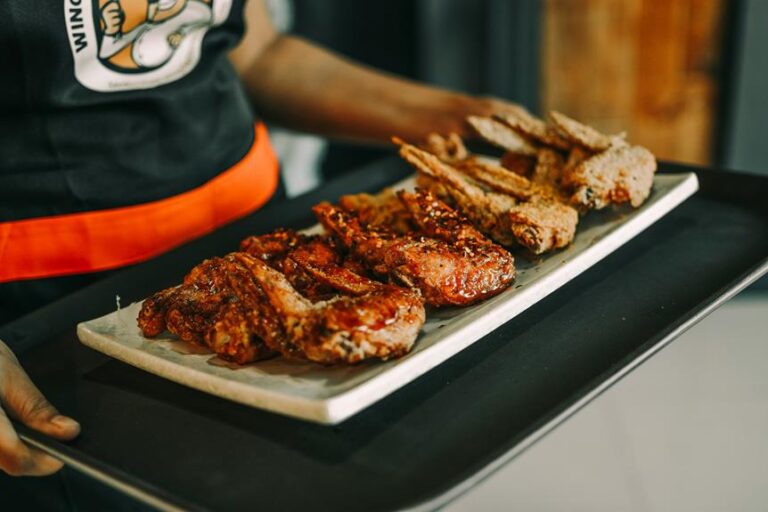Kare-Kare: A Rich and Creamy Filipino Stew You Need to Try
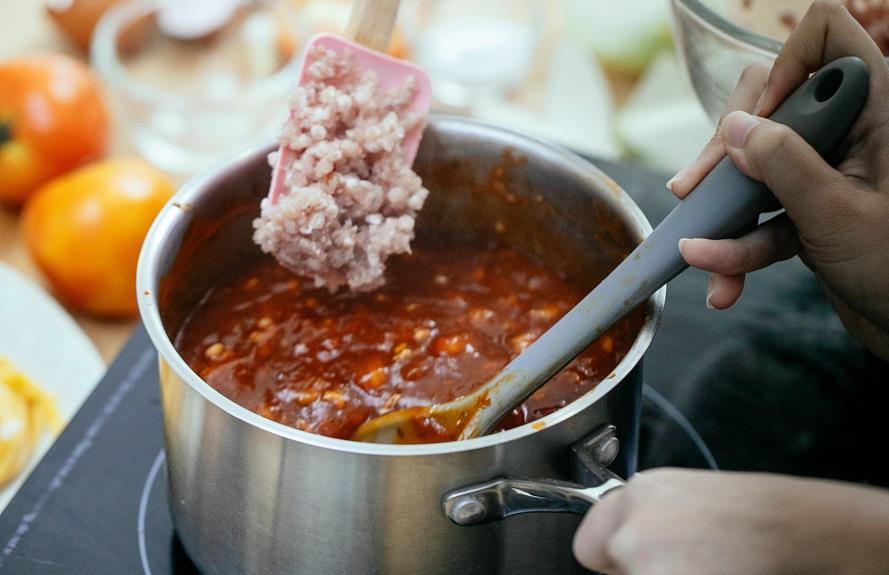
You can't truly appreciate Filipino cuisine without tasting Kare-Kare, a rich and creamy stew that'll captivate your taste buds. Originating from Pampanga, this dish boasts a luscious peanut sauce enveloping tender oxtail, tripe, and a medley of vibrant vegetables like eggplant and banana heart. It's a staple at fiestas and family gatherings, symbolizing unity and shared heritage. The secret's in its slow-cooked meat and velvety sauce made from ground peanuts and toasted rice. Served with steamed rice and a side of bagoong (shrimp paste), it's an experience you won't forget. Discover more about this mouthwatering tradition and its variations.
Key Takeaways
- Kare-Kare is a traditional Filipino stew known for its creamy peanut sauce and rich flavors.
- The dish features oxtail, tripe, and a variety of vegetables like eggplant and banana heart.
- Slow cooking ensures the meat is tender and absorbs the stew's flavors.
- The rich, velvety sauce is made with peanut butter, ground toasted rice, and annatto powder.
- Typically served with steamed rice and optional sides like crispy bagnet for added texture.
What Is Kare-Kare?
Kare-Kare is a beloved Filipino stew renowned for its creamy peanut sauce and hearty ingredients. This traditional dish has deep roots in Filipino history, with its origins tracing back to the culinary traditions of the Pampanga region. Known for their rich and flavorful cuisine, Pampangans consider Kare-Kare a staple at special occasions and fiestas, showcasing their knack for creating comforting and celebratory meals.
The cultural significance of Kare-Kare extends beyond its delicious taste. It's often a centerpiece during family gatherings, symbolizing unity and shared heritage. The unique combination of oxtail, tripe, and vegetables like eggplant, banana heart, and string beans speaks volumes about the Filipino way of bringing diverse elements together to create something harmonious and delightful.
Kare-Kare's rich, nutty flavor is complemented by ground toasted rice and annatto, which also give it its distinct color. Serving it with shrimp paste, locally known as bagoong, adds a layer of depth that elevates the dish.
In many Filipino homes, preparing Kare-Kare is a labor of love, passed down through generations, making it not just a meal, but a cherished tradition that continues to bring people together.
Ingredients Overview
A delightful symphony of flavors awaits in Kare-Kare, where tender oxtail, succulent tripe, and a medley of vegetables meld harmoniously in a luscious, creamy peanut sauce. The distinct flavor profile of Kare-Kare is built upon the richness of peanut butter and the subtle thickness added by rice flour, creating a sauce that's both savory and slightly sweet. Key vegetables like banana heart, eggplant, string beans, and pechay contribute to the dish's vibrant color and texture.
Understanding the cultural significance of Kare-Kare is important. This beloved stew is often the centerpiece at Filipino celebrations and fiestas, especially in Pampanga, a region renowned for its culinary heritage. Each region might have its own variations, with some adding seafood or more vegetables to the mix.
Cooking techniques play a vital role in achieving that perfect Kare-Kare. Slow-cooking the oxtail and tripe until they're tender guarantees that the meat absorbs the flavors of the sauce. The thick peanut sauce, often enriched with peanut butter, is what makes this dish stand out. Don't forget the bagoong (shrimp paste) served on the side—it adds a salty, umami kick that enhances every bite.
Preparing the Meat
To prepare the meat for Kare-Kare, start by choosing your preferred cuts like oxtail, beef, pork hocks, or tripe. Oxtail is a traditional favorite because its gelatinous texture brings a unique richness to the stew. Whichever meat you choose, the slow cooking process is vital to achieving the tender, flavorful outcome that makes Kare-Kare so distinctive.
Begin by rinsing the meat thoroughly to remove any impurities. For oxtail or beef, cut it into manageable pieces. If you opt for pork hocks or tripe, make sure they're cleaned and trimmed properly. Place the meat in a large pot and cover it with water. Bring this to a boil, then reduce to a simmer, skimming off any foam that rises to the surface.
Slow cooking your selected meat allows it to become melt-in-your-mouth tender while absorbing the delicious flavors of the broth. This step is essential because it forms the foundation of your Kare-Kare, ensuring the meat stands out against the creamy peanut sauce. Let it simmer gently for a couple of hours until the meat is soft and the broth is rich and aromatic.
Cooking the Vegetables
When cooking the vegetables for your kare-kare, you'll want to blanch the banana heart, eggplant, long beans, and pechay until they're just tender. This technique preserves their vibrant colors and crisp texture intact, enhancing the dish's overall appeal.
Remember to add the blanched vegetables towards the end to guarantee they stay fresh and flavorful.
Blanching Vegetable Techniques
Blanching vegetables is an essential step that helps they maintain their vibrant color, crisp texture, and essential nutrients when preparing a dish like Kare-Kare. One of the primary blanching benefits is that it locks in the freshness of your vegetables, making them not only look appealing but also taste better.
Best practices for blanching involve immersing your vegetables in boiling water for just a few minutes. This quick process halts enzyme actions which can cause loss of flavor, color, and texture.
For the best results, follow these vegetable blanching tips and tricks: First, make sure to prepare an ice bath before you start blanching. This ice bath will shock the vegetables and stop the cooking process immediately, preventing them from becoming mushy. Timing is essential, so keep a close eye on the clock and avoid overcooking.
After blanching, the vegetables should be vibrant and slightly tender. They can then be added to your Kare-Kare, enhancing both the visual appeal and the overall flavor of the dish.
Prepping Fresh Ingredients
Now that your vegetables are blanched to perfection, it's time to focus on cooking them just right to complement the rich, creamy Kare-Kare stew. Properly cooked vegetables not only add layers of flavor and nutrition but also enhance the dish's visual appeal. Let's explore the next steps to make sure your vegetables maintain their vibrant colors and crisp textures.
First, consider vegetable assortment. Popular choices include banana heart, eggplant, long beans, and pechay. Each brings a unique flavor and texture to your Kare-Kare.
Here are key tips for cooking the vegetables:
- Color preservation: Quickly blanching the vegetables helps retain their vivid hues. Make sure not to overcook them in the stew.
- Texture retention: Cook vegetables separately until they're tender but still slightly firm. This keeps them from becoming mushy when added to the stew.
- Flavor balance: The combination of blanched vegetables and savory peanut sauce creates a harmonious blend of taste and texture.
Making the Sauce
To craft the rich and creamy peanut sauce that defines Kare-Kare, you'll begin by combining ground peanuts or peanut butter with ground toasted rice for a hearty foundation. This blend is essential for the sauce's distinctive texture and flavor enhancement. The ground toasted rice not only thickens the sauce but also adds a subtle nuttiness, perfectly complementing the peanut preparation.
Afterward, you'll sauté garlic and onions until they're aromatic, which forms the flavorful base of the sauce. Integrate the peanut and rice mixture, stirring continuously to prevent lumps. For sauce thickening, let it simmer gently, allowing the ingredients to blend into a unified and velvety consistency.
To achieve that lively orange hue, add annatto powder—this color infusion isn't only for appearance but also imparts a gentle earthiness. Don't overlook balancing the sauce with a touch of fish sauce, introducing a hint of umami that enhances the overall flavor profile.
Simmer the mixture slowly, ensuring all the flavors meld together harmoniously. The outcome is a delightfully flavorful and indulgent base that will elevate your Kare-Kare to new culinary heights.
Combining Everything
Now that you've crafted the rich peanut sauce, it's time to bring everything together.
Gently fold in the tender oxtail and fresh vegetables, ensuring each piece is well-coated.
Stir until the stew reaches that perfect creamy consistency, making sure every bite bursts with flavor.
Mixing Main Ingredients
As the broth simmers, it's time to carefully fold in the tender oxtail and blanched vegetables, making sure every piece is coated with the rich, peanut-infused sauce. This step brings together all the flavorful combinations you've been working on. Using precise cooking techniques, integrate the oxtail with vegetables like banana heart, eggplant, long beans, and pechay. These ingredient pairings not only add texture but also enhance the overall taste of the stew.
By this point, your kitchen should be filled with the tantalizing aroma of onions, garlic, and fish sauce simmering away. These aromatic ingredients are essential for layering flavors and achieving that perfect Kare-Kare taste. Don't rush this process—take your time to taste test and adjust as needed.
- Blanched Vegetables: Make sure each vegetable retains its vibrant color and crisp texture.
- Peanut-Infused Sauce: Stir consistently to maintain a creamy consistency.
- Tender Oxtail: See to it that it's fall-off-the-bone tender for maximum flavor absorption.
Combining everything correctly is vital to make your Kare-Kare stew not just a meal, but an experience. Serve it hot, with a side of shrimp paste for that authentic Filipino touch.
Achieving Perfect Consistency
Mastering the perfect consistency of Kare-Kare requires a delicate blend of technique and patience, ensuring every element melds seamlessly into a harmonious, velvety stew. Start by toasting rice flour and combining it with the broth, creating a thickening agent that forms the backbone of Kare-Kare's signature texture. This step is essential in achieving the desired thickness without compromising the stew's smoothness.
Next, dissolve annatto powder in the broth. This colorful addition not only enhances the visual appeal but also infuses a subtle, earthy flavor that complements the dish. The vibrant hue from the annatto powder will make your Kare-Kare as delightful to look at as it's to eat.
Incorporate creamy peanut butter into the mix, stirring it thoroughly to meld with the thickened broth. This step is crucial for flavor enhancing, as the peanut butter imparts a rich, nutty profile that defines Kare-Kare's unique taste.
Serving Suggestions
Enhance your Kare-Kare experience by serving it with a side of bagoong alamang, which adds a delicious contrast to the rich peanut sauce. This fermented shrimp paste's salty and umami flavors perfectly balance the creamy, nutty stew.
For a complete feast, consider these pairing suggestions and presentation ideas:
- Steamed white rice: The neutral taste of steamed rice allows you to relish the complex flavor combinations of the Kare-Kare and bagoong.
- Crispy bagnet or lechon kawali: These crispy fried pork options add a delightful crunch and extra layer of tastiness to your meal.
- Chopped chili peppers or chili garlic sauce: For those who enjoy a bit of heat, these garnish options provide a spicy kick that elevates the dish.
Don't forget to add a squeeze of calamansi juice for a hint of citrusy tang that brightens up the flavors. Serve your Kare-Kare in a large, vibrant bowl to highlight its rich, golden-brown hue and sprinkle some fresh herbs on top for a pop of color.
This engaging presentation will make your Kare-Kare not only taste incredible but look stunning as well. Enjoy every bite of this sumptuous stew!
Nutrition Facts
Understanding Kare-Kare's nutrition details can help you appreciate the health benefits hidden within this delicious Filipino stew. At its core, Kare-Kare boasts a rich and creamy peanut sauce, providing not only a delightful flavor profile but also healthy fats from the peanut butter.
The use of oxtail and tripe ensures that the dish is packed with protein, which is vital for muscle maintenance and repair.
Vegetables like eggplant, banana heart, and string beans add fiber, vitamins, and minerals, making Kare-Kare a well-rounded meal. The cultural significance of this dish is immense, often gracing the tables during special occasions and celebrations in the Philippines. This adds to its allure, making each bite a flavorful connection to Filipino heritage.
For those mindful of their diet, dietary adjustments can be easily made. For instance, you can substitute the oxtail with leaner cuts of meat or even tofu for a vegetarian twist without compromising the rich flavor profile. Even opting for low-sodium peanut butter can make a significant difference.
And of course, the traditional side of shrimp paste or bagoong adds an extra layer of umami, enhancing the overall dining experience.
Variations of Kare-Kare
Kare-Kare's versatility shines through its many variations, where you can find it prepared with oxtail, beef, chicken, or even plant-based proteins like tofu and mushrooms. This rich and creamy Filipino stew is a canvas for unique combinations and regional influences, making each version a delightful discovery.
You can experience Kare-Kare in various forms:
- Meat substitutes like tofu and mushrooms offer a delicious vegetarian twist.
- Regional influences bring diverse ingredients such as tripe, pork hocks, or even lechon (roasted pig).
- Thickening methods vary, with some recipes using ground toasted rice instead of peanut butter for a different texture.
The magic of Kare-Kare lies in its adaptability. While traditional recipes often feature oxtail, don't hesitate to try versions with beef, chicken, or seafood.
Vegetarians won't miss out either, thanks to the hearty flavors of tofu and mushrooms that blend seamlessly with the rich peanut sauce. Regional influences add even more layers of flavor, with some areas of the Philippines incorporating local ingredients to create unique combinations.
No matter which variation you choose, the essence of Kare-Kare — its comforting, delightful goodness — remains the same. Each bite offers a taste of Filipino culinary heritage, inviting you to explore and enjoy this beloved dish in all its forms.
Reader Comments and Feedback
Reader comments and feedback are invaluable for creating a lively and engaging culinary community around Kare-Kare. When you share your thoughts, it not only enriches the experience for yourself but also for others who are keen to explore this delightful Filipino stew.
Whether you're asking for clarification on certain cooking techniques or offering insights on ingredient substitutions, your input helps everyone.
Many readers enjoy discussing recipe modifications to suit their individual taste preferences. For instance, some may suggest adding more peanut butter for a richer flavor, while others might prefer a lighter version with less. Ingredient substitutions are another hot topic. Can't find oxtail? No problem—many suggest using beef shank or even pork hock as delicious alternatives.
Comment moderation ensures that the conversation remains respectful and constructive, allowing for a positive exchange of ideas. Previous comments and replies are visible, so you can draw inspiration from others who've successfully tailored the dish to their liking. Recipe ratings also provide a quick gauge of the dish's popularity and success, helping you decide if it's worth a try.
Immerse yourself and share your Kare-Kare journey with the community!
Frequently Asked Questions
How Long Does Kare-Kare Take to Cook?
You're looking at a cooking time of about 4 hours for Kare-Kare using the traditional method. The oxtail needs to simmer for a couple of hours, and the vegetables and rich peanut sauce add more time.
Can I Make Kare-Kare in an Instant Pot?
Yes, you can make Kare-Kare in an Instant Pot! Instant Pot modifications will save you time, and its pressure cooking can enhance flavor variations, making it a convenient way to enjoy this delicious Filipino stew.
What Are Some Vegetarian Alternatives for Kare-Kare?
For vegetarian alternatives, you've got tofu options, tempeh, or seitan as meat substitutes. Enhance your dish with eggplant, string beans, and banana blossoms. Peanut butter provides the creamy base, making it rich and flavorful.
How Do You Store and Reheat Leftovers?
To store, place your leftovers in an airtight container and refrigerate for 3-4 days. For reheating instructions, gently warm in a saucepan on low or microwave with a lid, adding water or broth to maintain consistency.
Is Kare-Kare Gluten-Free?
Yes, Kare-Kare can be gluten-free! Use traditional ingredients like oxtail and vegetables. Guarantee gluten-free alternatives for condiments like soy sauce. Always check labels for hidden gluten to enjoy this delicious stew worry-free.
Conclusion
You've now got all the know-how to whip up a delightful pot of kare-kare. This rich, creamy Filipino stew, with its tender meats, vibrant vegetables, and flavorful peanut sauce, is sure to become a favorite in your household.
Don't be afraid to get creative with variations and make it your own. Serve it up with a side of bagoong and a steaming bowl of rice, and you'll have an unforgettable meal.
Enjoy!

